This site uses cookies as defined in our Cookie Policy, by continuing to use this site you agree to their use.
Continue
| Arrive | Depart | ||||||
| 23rd23 | JanJan | 202424 | Valparaiso, Chile, embark on the Serenade of the Seas | 16:00 | |||
| Valparaíso's dramatic topography—45 cerros, or hills, overlooking the ocean—requires the use of winding pathways and wooden ascensores (funiculars) to get up many of the grades. The slopes are covered by candy-color houses—there are almost no apartments in the city—most of which have exteriors of corrugated metal peeled from shipping containers decades ago. Valparaíso has served as Santiago's port for centuries. Before the Panama Canal opened, Valparaíso was the busiest port in South America. Harsh realities—changing trade routes, industrial decline—have diminished its importance, but it remains Chile's principal port. Most shops, banks, restaurants, bars, and other businesses cluster along the handful of streets called El Plan (the flat area) that are closest to the shoreline. Porteños (which means "the residents of the port") live in the surrounding hills in an undulating array of colorful abodes. At the top of any of the dozens of stairways, the paseos (promenades) have spectacular views; many are named after prominent Yugoslavian, Basque, and German immigrants. Neighborhoods are named for the hills they cover. With the jumble of power lines overhead and the hundreds of buses that slow down—but never completely stop—to pick up agile riders, it's hard to forget you're in a city. Still, walking is the best way to experience Valparaíso. Be careful where you step, though—locals aren't very conscientious about curbing their dogs. | |||||||
| 24th24 | JanJan | 202424 | Coquimbo, Chile | 07:00 | 16:00 | ||
| The name Coquimbo is derived from a native Diaguita word meaning 'place of calm waters'. In fact, Charles Darwin had noted that the town was 'remarkable for nothing but its extreme quietness'. Since then, Coquimbo has developed into a bustling port and the region's major commercial and industrial centre from which minerals, fish products and fruits are exported. Used during the colonial period as a port for La Serena, Coquimbo attracted attention from English pirates, including Sir Francis Drake, who visited in 1578. Visitors enjoy strolling around the town, admiring some of the elaborate woodwork handcrafted on buildings by early British and American settlers. These wooden buildings are among Chile's most interesting historical structures. Out of town, the area offers some fine beaches in a desert-like setting. Coquimbo serves as a gateway to the popular resort town of La Serena and trips farther into the Elqui Valley, known as the production centre for Chile's national drink, pisco sour. The valley is also home to several international observatories that take advantage of the region's exceptional atmospheric conditions. | |||||||
| 25th25 | JanJan | 202424 | At Sea | ||||
| 26th26 | JanJan | 202424 | Arica, Chile | 11:00 | 21:00 | ||
| Arica boasts that it is "the land of the eternal spring," but its temperate climate and beaches are not the only reason to visit this small city. Relax for an hour or two on the Plaza 21 de Mayo. Walk to the pier and watch the pelicans and sea lions trail the fishing boats as the afternoon's catch comes in. Walk to the top of the Morro and imagine battles of days gone by, or wonder at the magnitude of modern shipping as Chilean goods leave the port below by container ship.Arica is gaining notice for its great surfing conditions, and in 2009 hosted the Rusty Arica Pro Surf Challenge, a qualifying event to the world series of surf. | |||||||
| 27th27 | JanJan | 202424 | At Sea | ||||
| 28th28 | JanJan | 202424 | Pisco, Peru | 07:00 | 19:00 | ||
| Lending its name to the clear brandy that is Peru's favorite tipple and a source of fierce national pride, the coastal town of Pisco and its surroundings hold a special place in the national psyche. It's the point where the Argentinean hero General San Martín landed with his troops to fight for Peru's freedom from Spanish rule. It's the city from which pisco was first exported, and it's also an important seaport that had its heyday during the 1920s, when guano (bird droppings used as fertilizer) from the nearby Islas Ballestas were worth nearly as much as gold.Modern-day Pisco shows little evidence of its celebrated past. Instead, what you'll find is a city struggling to get back on its feet after the disaster of August 2007, when a magnitude 8 earthquake shook the town for three minutes. Disregard for planning permission, illegal building extensions, and the use of adobe (mud brick) as the main building material had left a vast number of Pisco's buildings unable to withstand the quake, and hundreds of lives were lost as homes, churches, and hospitals collapsed during the tremor.Most travelers now base themselves in Paracas, just a few kilometers down the coast. For travelers wishing to assist in Pisco's recovery, there are numerous opportunities to volunteer. Organizations active in the area vary over time, but a good place to start looking for current opportunities is www.idealist.org. Even those without the time to volunteer should know that every nuevo sol spent in local businesses is contributing to rebuilding the region's economy. | |||||||
| 29th29 | JanJan | 202424 | Callao, Peru | 07:00 | |||
| When people discuss great South American cities, Lima is often overlooked. But Peru's capital can hold its own against its neighbors. It has an oceanfront setting, colonial-era splendor, sophisticated dining, and nonstop nightlife.It's true that the city—clogged with traffic and choked with fumes—doesn't make a good first impression, especially since the airport is in an industrial neighborhood. But wander around the regal edifices surrounding the Plaza de Armas, among the gnarled olive trees of San Isidro's Parque El Olivar, or along the winding lanes in the coastal community of Barranco, and you'll find yourself charmed.In 1535 Francisco Pizarro found the perfect place for the capital of Spain's colonial empire. On a natural port, the so-called Ciudad de los Reyes (City of Kings) allowed Spain to ship home all the gold the conquistador plundered from the Inca. Lima served as the capital of Spain's South American empire for 300 years, and it's safe to say that no other colonial city enjoyed such power and prestige during this period.When Peru declared its independence from Spain in 1821, the declaration was read in the square that Pizarro had so carefully designed. Many of the colonial-era buildings around the Plaza de Armas are standing today. Walk a few blocks in any direction for churches and elegant houses that reveal just how wealthy this city once was. But the poor state of most buildings attests to the fact that the country's wealthy families have moved to neighborhoods to the south over the past century.The walls that surrounded the city were demolished in 1870, making way for unprecedented growth. A former hacienda became the graceful residential neighborhood of San Isidro. In the early 1920s the construction of tree-lined Avenida Arequipa heralded the development of neighborhoods such as bustling Miraflores and bohemian Barranco.Almost a third of the country's population of 29 million lives in the metropolitan area, many of them in relatively poor conos: newer neighborhoods on the outskirts of the city. Most residents of those neighborhoods moved there from mountain villages during the political violence and poverty that marked the 1980s and ’90s, when crime increased dramatically. During the past decade the country has enjoyed peace and steady economic growth, which have been accompanied by many improvements and refurbishment in the city. Residents who used to steer clear of the historic center now stroll along its streets. And many travelers who once would have avoided the city altogether now plan to spend a day here and end up staying two or three. | |||||||
| 30th30 | JanJan | 202424 | Callao, Peru | 13:00 | |||
| When people discuss great South American cities, Lima is often overlooked. But Peru's capital can hold its own against its neighbors. It has an oceanfront setting, colonial-era splendor, sophisticated dining, and nonstop nightlife.It's true that the city—clogged with traffic and choked with fumes—doesn't make a good first impression, especially since the airport is in an industrial neighborhood. But wander around the regal edifices surrounding the Plaza de Armas, among the gnarled olive trees of San Isidro's Parque El Olivar, or along the winding lanes in the coastal community of Barranco, and you'll find yourself charmed.In 1535 Francisco Pizarro found the perfect place for the capital of Spain's colonial empire. On a natural port, the so-called Ciudad de los Reyes (City of Kings) allowed Spain to ship home all the gold the conquistador plundered from the Inca. Lima served as the capital of Spain's South American empire for 300 years, and it's safe to say that no other colonial city enjoyed such power and prestige during this period.When Peru declared its independence from Spain in 1821, the declaration was read in the square that Pizarro had so carefully designed. Many of the colonial-era buildings around the Plaza de Armas are standing today. Walk a few blocks in any direction for churches and elegant houses that reveal just how wealthy this city once was. But the poor state of most buildings attests to the fact that the country's wealthy families have moved to neighborhoods to the south over the past century.The walls that surrounded the city were demolished in 1870, making way for unprecedented growth. A former hacienda became the graceful residential neighborhood of San Isidro. In the early 1920s the construction of tree-lined Avenida Arequipa heralded the development of neighborhoods such as bustling Miraflores and bohemian Barranco.Almost a third of the country's population of 29 million lives in the metropolitan area, many of them in relatively poor conos: newer neighborhoods on the outskirts of the city. Most residents of those neighborhoods moved there from mountain villages during the political violence and poverty that marked the 1980s and ’90s, when crime increased dramatically. During the past decade the country has enjoyed peace and steady economic growth, which have been accompanied by many improvements and refurbishment in the city. Residents who used to steer clear of the historic center now stroll along its streets. And many travelers who once would have avoided the city altogether now plan to spend a day here and end up staying two or three. | |||||||
| 31st31 | JanJan | 202424 | At Sea | ||||
| 1st01 | FebFeb | 202424 | Manta, Ecuador | 10:00 | 17:00 | ||
| 2nd02 | FebFeb | 202424 | At Sea | ||||
| 3rd03 | FebFeb | 202424 | Puntarenas, Costa Rica | 10:00 | 19:00 | ||
| This town is not on the Nicoya Peninsula, but rather on Costa Rica's mainland. It is best known as a cruise-ship port and launching pad for ferries heading southeast to the coast of the Nicoya Peninsula and for cruises sailing out on the Gulf of Nicoya. Puntarenas is also a major fishing port with a lively fish market. The town’s reputation suffers from the unimpressive parts you see from your car as you roll through town on the way to the ferry dock. But the town has a lot of character off the main drag, thanks to its illustrious past as an affluent port town and principal vacation spot for San José's wealthy, who arrived by train in the last century. Once the port was moved and roads opened to other beaches, Puntarenas's economy crashed, but it's making a comeback. Sitting on a narrow spit of sand—punta de arenas literally means "point of sand"—that protrudes into the Gulf of Nicoya, the town boasts a beautifully groomed, wide Blue Flag beach with views of the Nicoya Peninsula and spectacular sunsets, along with a public swimming pool, the San Lucas Beach Club, and a marine-life museum. Ticos arrive by bus and car to enjoy the beach and stroll the Paseo de los Turistas, a beachfront promenade lined with tree-shaded concrete benches and seafood restaurants. Crowds of locals, called porteños, cruise by on bicycles, the town’s most popular form of transport. | |||||||
| 4th04 | FebFeb | 202424 | At Sea | ||||
| 5th05 | FebFeb | 202424 | Puerto Quetzal, Guatemala | 07:00 | 16:00 | ||
| Puerto Quetzal is Guatemala's largest Pacific Ocean port. It is important for both cargo traffic and as a stop-off point for cruise liners | |||||||
| 6th06 | FebFeb | 202424 | At Sea | ||||
| 7th07 | FebFeb | 202424 | At Sea | ||||
| 8th08 | FebFeb | 202424 | Cabo San Lucas, Mexico | 11:00 | 19:00 | ||
| Cabo San Lucas, a resort city on the southern tip of Mexico’s Baja California peninsula, is known for its beaches, water-based activities and nightlife. Playa El Médano is Cabo’s main beach, with outdoor restaurants and numerous bars. Past the marina is Land's End promontory, site of Playa del Amor (Lover's Beach) and El Arco, a natural archway in the seacliffs. | |||||||
| 9th09 | FebFeb | 202424 | At Sea | ||||
| 10th10 | FebFeb | 202424 | Ensenada, Mexico | 11:00 | 19:00 | ||
| Ensenada is a port city on the Pacific coast of Mexico’s Baja California peninsula. At its heart is the harbor and waterfront area with the Malecón promenade. Once a casino, the Riviera de Ensenada is now a cultural center. The nearby Museum of History and the Regional Historical Museum trace the area’s people and past. Migrating gray whales visit the waters offshore. Southwest of the city is La Bufadora blowhole. | |||||||
| 11th11 | FebFeb | 202424 | Los Angeles, California, United States, disembark the Serenade of the Seas | 07:00 | |||
| Home of the famous Hollywood sign and Walk of Fame, Los Angeles is the place to visit for anyone interested in film and television and hoping to get a glimpse at some famous actors and artists. Stroll down the Walk and enjoy the glamorous atmosphere and famous surroundings, or take a break on the Santa Monica pier and watch the sun set on the sea. | |||||||
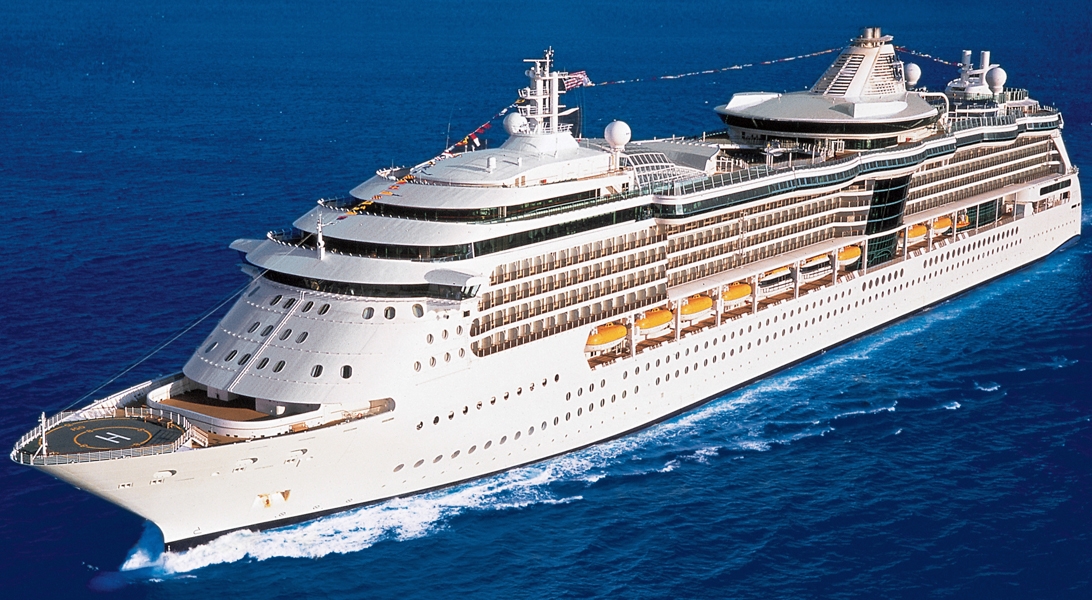












The images shown are for illustration purposes only and may not be an exact representation of what you find on the ship.
The images shown are for illustration purposes only and may not be an exact representation of what you find on the ship.
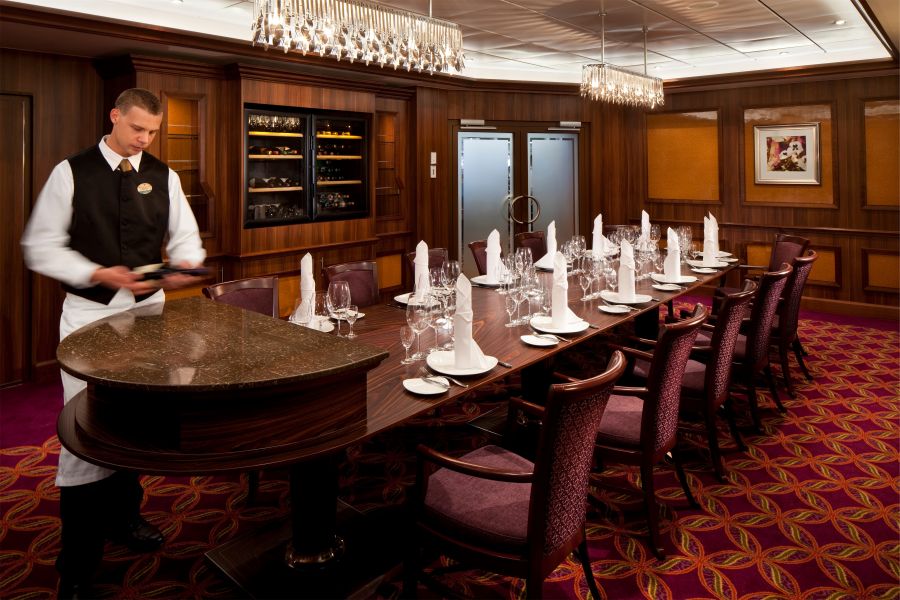
AS VIP AND INTIMATE AS CAN BE
Welcome to Chef’s Table, the most exclusive and elevated dining experience on our fleet. Join an intimate group of fellow foodies on a private epicurean journey led by the ship’s Chef de Cuisine. You’ll sit down to a white tablecloth dinner spotlighting five exquisite courses that range from scallop carpaccio with yuzu vinaigrette, to grilled filet mignon served with truffle potato puree — each expertly paired with the perfect wine to highlight every flavour on the menu.
ATTIRE
Formal
NOTE
Available on select sailings.
MENU HIGHLIGHTS
Start your meal with the Scallop carpaccio, served with yuzu vinaigrette and crispy quinoa. Then transition to the Smoked tomato soup, sprinkled with garlic focaccia croutons and parmesan. Seafood lovers rave about the Maine lobster salad, flavoured with pineapple, cilantro, and vanilla dressing, and the Roasted branzino paired with grilled vegetables and lemon confit. Blending peanut butter ganache, Valrhona chocolate mousse, and salted caramel gelato, our signature dessert, The world, is the ultimate sweet ending.
PRO TIP
Each dish is paired with a somm-selected glass of premium red or white wine.

EAT MORE ITALIAN
Every meal at Giovanni’s Table is a family-style celebration of rustic Italian flavour. You’ll find all your favourite Old-World classics on the menu here, like house focaccia served with marinated artichokes, olives and pesto, fluffy gnocchi tossed in a thyme-scented sauce of lamb and root vegetables, traditional risotto finished with porcini and truffle mushroom tapenade and veal osso buco paired with creamy cheese polenta, ripe tomatoes and sautéed green beans.
ATTIRE
Smart Casual
HOW TO PURCHASE
Cruise Planner or Onboard
MENU HIGHLIGHTS
First things first – ask for an order of the house focaccia, which comes with marinated artichokes, olives and pesto. And don’t miss the antipasti per due, an appetiser big enough for two that comes heaped with Italian salami, prosciutto, marinated anchovies, grilled artichokes, Cambozola cheese and more. There are plenty of tasty options to choose from if you’re a pasta lover, from parpadelle with pancetta in a rich radicchio cream, to taglierini tossed with cherry tomatoes, calamari, bay scallops and pesto. And if you’re craving a hearty Italian-style main course, try the polpette alla romana — tender veal meatballs in a rich tomato-herb sauce — or the costolette d’agnello alle erbe — grilled lamb chops served in a Merlot reduction with baby vegetable caponata and sautéed spinach.
PRO TIP
Giovanni’s Table is a great restaurant to dial up date night. If you’re celebrating a special occasion, just let the staff know ahead of time. They’ll help make it extra special!

GOURMET COURSES
In the Main Dining Room, you can experience flavours that take you from Jamaica to Jaipur, a rotating menu of delicious dishes always offering something unexpected. A multi-level restaurant that in the morning is the perfect spot to enjoy a hearty brunch paired with refreshing mimosas, at dinnertime transforms into a world class dining experience with a menu that invites you to taste your way around the world course by course.
ATTIRE
Smart Casual
MENU HIGHLIGHTS
Many of the dishes on the Main Dining Room’s menu rotate each night, which means you could go an entire week without ever repeating a course. Every meal here begins with something delicious from the starters section of the menu — like savoury duck terrine layered with apricot chutney on toasted sourdough bread, a flaky Vidalia onion tart baked with whipped eggs, cream, and smoked bacon, or spiced eggplant and Kalamata olive tartare prepared with red pepper hummus and served on crispy garlic bread. Then, choose from international entrees like Moroccan spiced ahi tuna served over mint couscous, sautéed spinach and tequila peppers with a cool yogurt vinaigrette. Or mojo-marinated bone-in pork loin paired with sweet potatoes, broccoli and a cumin-citrus reduction. Dessert is also worth getting excited about, with options like sweet cream-soaked tres leches, home-style carrot cake with cream cheese frosting, and a light and fluffy Grand Marnier soufflé.
NOTE
Food offerings may differ by ship and sailing.
PRO TIP
The food in the Main Dining Room is complimentary, and you can order as many courses as you like.
The images shown are for illustration purposes only and may not be an exact representation of what you find on the ship.

From full-on thrillers to steamy romance, take your pick from the impressive library of books, featuring fiction and non-fiction. Read yours by the pool, water lapping your feet, or take one back to curl up with in bed.

SHAKING UP THE CLASSICS
Swanky, sophisticated, and suffused with retro style, R Bar serves up classic cocktails garnished with vintage vibes. Whether your drink of choice is a dry gin martini, an expertly mixed old fashioned, or the perfect gin and tonic, you’ll find plenty to savour here.
AGE RESTRICTION
21+ on sailings from North America, 18+ on sailings from South America, Europe, Asia, Australia and New Zealand.
MENU HIGHLIGHTS
The vintage décor at R Bar creates the perfect atmosphere to order a classic old fashioned or gimlet, but you should definitely also try one of the signature cocktails on the menu. Those who prefer their drinks on the fruity side will love the Purple Haze, made with Bacardi 8 rum, blue curacao and Pernod, and shaken with pineapple juice, passion fruit puree and a splash of grenadine. For a cocktail that doubles as dessert, opt for the aptly-named Red Velvet Cake, a decadent infusion of limoncello, dark chocolate liqueur, crème de cacao white and strawberry puree. If you’re craving something smooth, but strong, there’s the Green Goddess. It’s a potent blend of Belvedere vodka, Hennessy, blue curacao and mango puree, topped off with a twist of lemon. And for fans of fizzy drinks, it doesn’t get better than the Let’s Get Fizzical, a refreshingly light combination of passion fruit puree, apple juice and St-Germain elderflower liquere topped with prosecco.
PRO TIP
The bartenders here are pros. Let them surprise you with something that’s not on the menu.
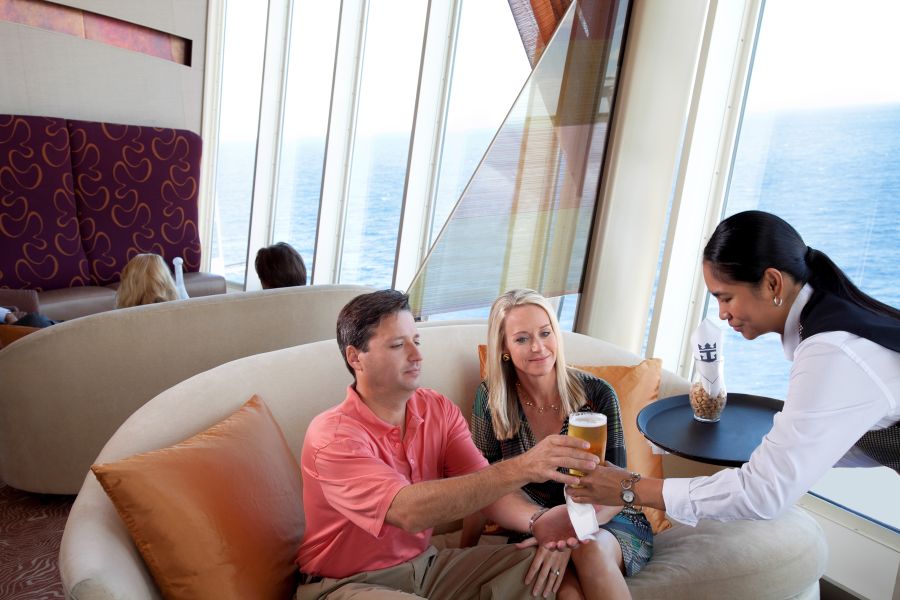
SAVOUR THE SIPS & THE SIGHTS
Our fleet’s signature architectural wonder, the Viking Crown Lounge® is the ultimate spot to soak up panoramic views while you sip your favourite cocktails. Catch the sunset through its floor-to-ceiling windows, then linger as the space comes alive with strobe lights, live music, and plenty of action on the dance floor.
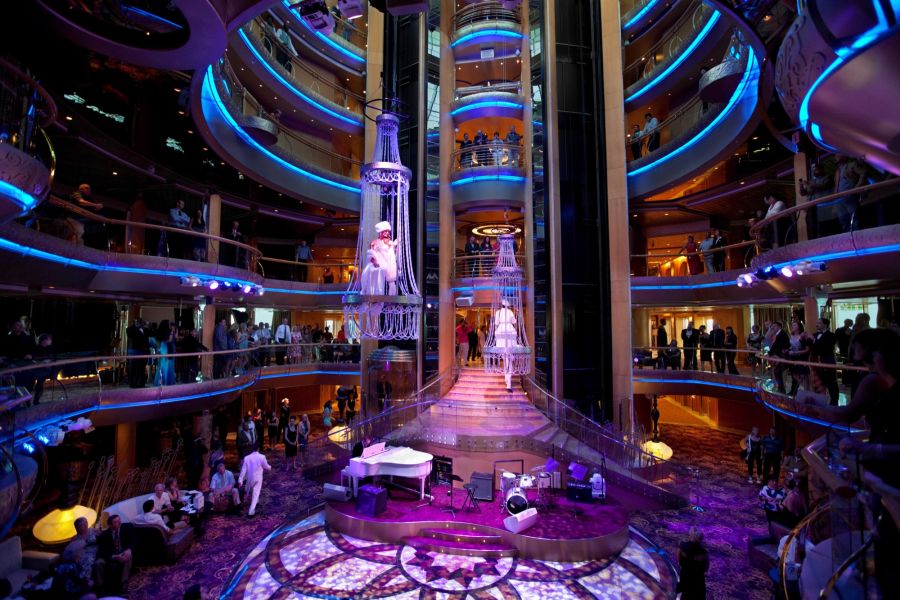
An area of activity both during the day (particularly on sea days) and at night with events ranging from cookery demonstrations and towel folding to live music, Nintendo Wii tennis tournaments, Salsa dance classes and 70’s disco parties.
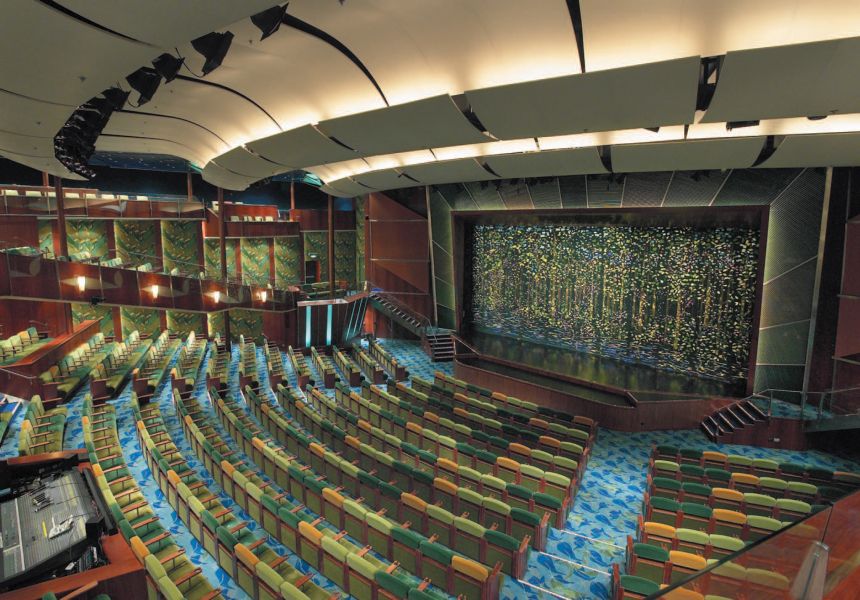
Arrive early and bag the best seats in the house for a night of fantastic Broadway-style entertainment at the onboard theatre.
The images shown are for illustration purposes only and may not be an exact representation of what you find on the ship.
The images shown are for illustration purposes only and may not be an exact representation of what you find on the ship.
| 19 nights aboard the Serenade of the Seas | |||
| Evening entertainment & Broadway style shows | |||
| Choice of traditional or anytime dining | |||
| Drinks Packages available | |||
| Speciality Restaurants (charges may apply) | |||
| 24-hour room service | |||
| Port Taxes and Fees | |||
 | ABTA and ATOL Protection* | ||
Date 23rd Jan 2024 |
Nts 19 |
Please Call for Availability |
Date 23rd Jan 2024 |
Nts 19 |
Please Call for Availability |
Fusion Cruises when selling travel arrangements is a trading name of The Midcounties Co-operative Ltd. Fusion Cruises is an Accredited Body Member of Midcounties Co-operative Travel Consortium. (ABTA:P6652, ATOL:6053).
Book with Confidence. We are a Member of ABTA which means you have the benefit of ABTA’s assistance and Code of Conduct.
Some of the flights and flight-inclusive holidays on this website are financially protected by the ATOL scheme but ATOL protection does not apply to all holiday and travel services offered on this website. This website will provide you with information on the protection that applies in the case of each holiday and travel service offered before you make your booking. If you do not receive an ATOL Certificate then the booking will not be ATOL protected. If you do receive an ATOL Certificate but all parts of your trip are not listed on it, those parts will not be ATOL protected. Please see our booking conditions for information, or for more information about financial protection and the ATOL Certificate go to: www.caa.co.uk
